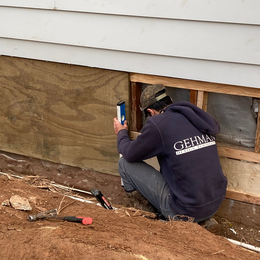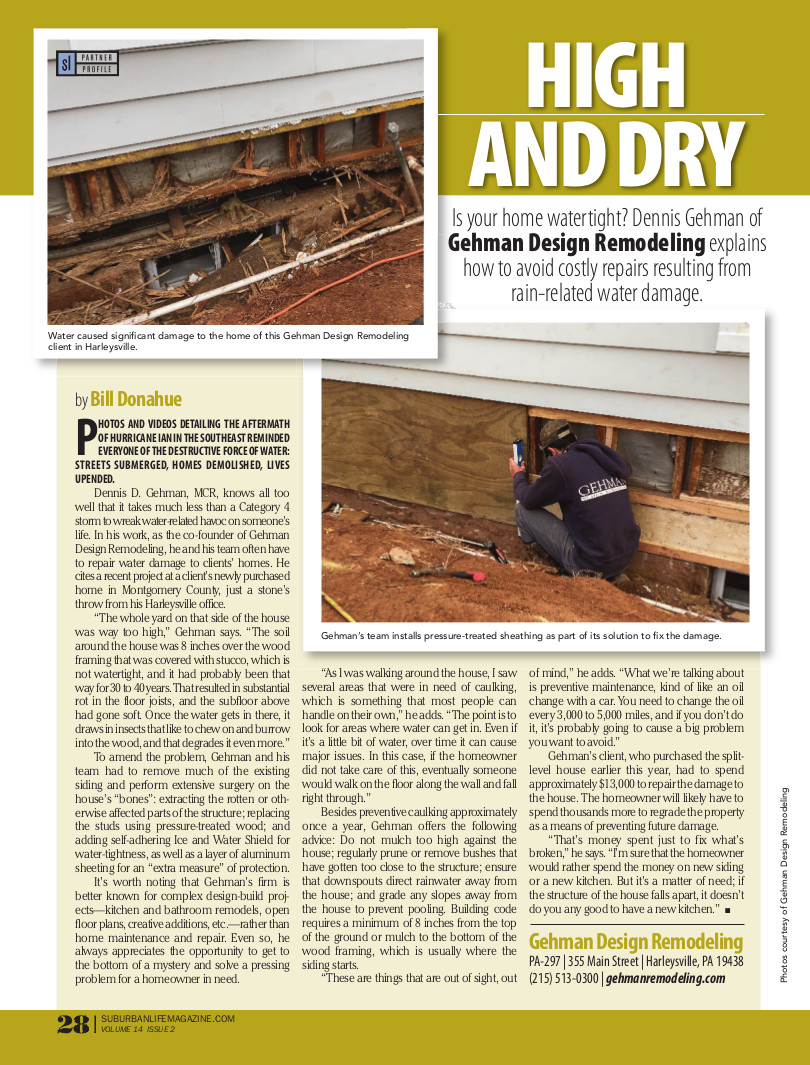
High and Dry
Is your home watertight? Dennis Gehman of Gehman Design Remodeling explains how to avoid costly repairs resulting from rain-related water damage.
Photos and videos detailing the aftermath of Hurricane Ian in the Southeast reminded everyone of the destructive force of water: streets submerged, homes demolished, lives upended.
Dennis D. Gehman, MCR, knows all too well that it takes much less than a Category 4 storm to wreak water-related havoc on someone’s life. In his work, as the co-founder of Gehman Design Remodeling, he and his team often have to repair water damage to clients’ homes. He cites a recent project at a client’s newly purchased home in Montgomery County, just a stone’s throw from his Harleysville office.
“The whole yard on that side of the house was way too high,” Gehman says. “The soil around the house was 8 inches over the wood framing that was covered with stucco, which is not watertight, and it had probably been that way for 30 to 40 years. That resulted in substantial rot in the floor joists, and the subfloor above had gone soft. Once the water gets in there, it draws in insects that like to chew on and burrow into the wood, and that degrades it even more.”
To amend the problem, Gehman and his team had to remove much of the existing siding and perform extensive surgery on the house’s “bones”: extracting the rotten or otherwise affected parts of the structure; replacing the studs using pressure-treated wood; and adding self-adhering Ice and Water Shield for water-tightness, as well as a layer of aluminum sheeting for an “extra measure” of protection.
It’s worth noting that Gehman’s firm is better known for complex design-build projects—kitchen and bathroom remodels, open floor plans, creative additions, etc.—rather than home maintenance and repair. Even so, he always appreciates the opportunity to get to the bottom of a mystery and solve a pressing problem for a homeowner in need.
“As I was walking around the house, I saw several areas that were in need of caulking, which is something that most people can handle on their own,” he adds. “The point is to look for areas where water can get in. Even if it’s a little bit of water, over time it can cause major issues. In this case, if the homeowner did not take care of this, eventually someone would walk on the floor along the wall and fall right through.”
Besides preventive caulking approximately once a year, Gehman offers the following advice: Do not mulch too high against the house; regularly prune or remove bushes that have gotten too close to the structure; ensure that downspouts direct rainwater away from the house; and grade any slopes away from the house to prevent pooling. Building code requires a minimum of 8 inches from the top of the ground or mulch to the bottom of the wood framing, which is usually where the siding starts.
“These are things that are out of sight, out of mind,” he adds. “What we’re talking about is preventive maintenance, kind of like an oil change with a car. You need to change the oil every 3,000 to 5,000 miles, and if you don’t do it, it’s probably going to cause a big problem you want to avoid.”
Gehman’s client, who purchased the split-level house earlier this year, had to spend approximately $13,000 to repair the damage to the house. The homeowner will likely have to spend thousands more to regrade the property as a means of preventing future damage.
“That’s money spent just to fix what’s broken,” he says. “I’m sure that the homeowner would rather spend the money on new siding or a new kitchen. But it’s a matter of need; if the structure of the house falls apart, it doesn’t do you any good to have a new kitchen.”
Gehman Design Remodeling
PA-297
355 Main Street
Harleysville, PA 19438
(215) 513-0300
gehmanremodeling.com
PA-297
355 Main Street
Harleysville, PA 19438
(215) 513-0300
gehmanremodeling.com
Photo courtesy of Gehman Design Remodeling
Published (and copyrighted) in Suburban Life, October 2022.



